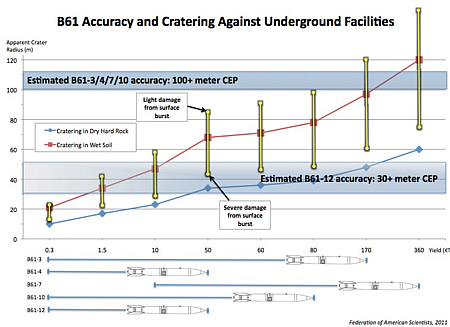B61 LEP: Increasing NATO Nuclear Capability and Precision Low-Yield Strikes
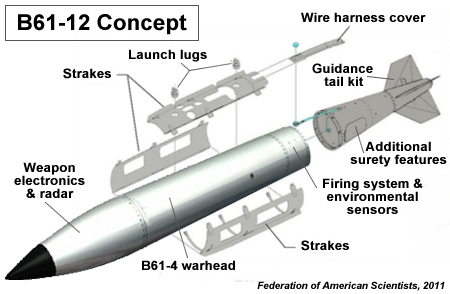 |
| The US military is planning to replace the tail section of the B61 nuclear bomb with a new guided tail kit to increase the accuracy of the weapon. This will increase the targeting capability of the weapon and allow lower-yield strikes against targets that previously required higher-yield weapons. Image: FAS Illustration |
.
By Hans M. Kristensen
A modified U.S. nuclear bomb currently under design will have improved military capabilities compared with older weapons and increase the targeting capability of NATO’s nuclear arsenal.
The B61-12, the product of a planned 30-year life extension and consolidation of four existing versions of the B61 into one, will be equipped with a new guidance system to increase its accuracy.
As a result, if funded by Congress, the U.S. non-strategic nuclear bombs currently deployed in five European countries will return to Europe as a life-extended version in 2018 with a significantly enhanced capability to knock out military targets.
Add to that the stealthy capability of the new F-35 aircraft being built to deliver the new weapon, and NATO is up for a significant nuclear upgrade.
The upgrade would also improve the capability of U.S. strategic bombers to destroy targets with lower yield and less radioactive fallout, a scenario that resembles the controversial PLYWD precision low-yield nuclear weapon proposal from the 1990s.
Finally, the B61-12 will mark the end of designated non-strategic nuclear warheads in the U.S. nuclear stockpile, essentially making concern over “disparity” with Russian non-strategic weapons a non-issue.
The Obama administration and Congress should reject plans to increase the accuracy of nuclear weapons and instead focus on maintaining the reliability of existing weapons while reducing their role and numbers.
Increasing Military Capabilities
It is U.S. nuclear policy that nuclear weapons “Life Extension Programs…will not support new military missions or provide for new military capabilities.” According to this policy stated in the Obama administration’s Nuclear Posture Review (NPR), the B61-12 cannot have new or greater military capabilities compared with the weapons it replaces.
Yet a new report published by the U.S. Government Accountability Office (GAO) reveals that the new bomb will have new characteristics that will increase the targeting capability of the nuclear weapons deployed in Europe.
It is important at this point to underscore that the official motivation for the new capabilities does not appear to be improved nuclear targeting against Russia or other potential adversaries. Nonetheless, that will be the effect.
The GAO report describes that the nuclear weapons designers were asked to “consider revisions to the bomb’s military performance requirements” to accommodate both non-strategic and strategic missions. This includes equipping the B61-12 with a new guided tail kit section in an $800 million Air Force program that is “designed to increase accuracy, enabling the military to achieve the same effects as the older bomb, but with lower nuclear yield.”
The B61 LEP consolidates four existing B61 types (non-strategic B61-3, B61-4 and B61-10, as well as the strategic B61-7) into one, so the new B61-12 must be able to meet the mission requirements for both the non-strategic and strategic versions. But since the B61-12 will use the nuclear explosive package of the B61-4, which has the lowest yield of the four types (a maximum of 50 kt), increasing the accuracy was added to essentially turn the B61-4 into a B61-7 in terms of targeting capability.
| Consolidating Four Bombs Into One |
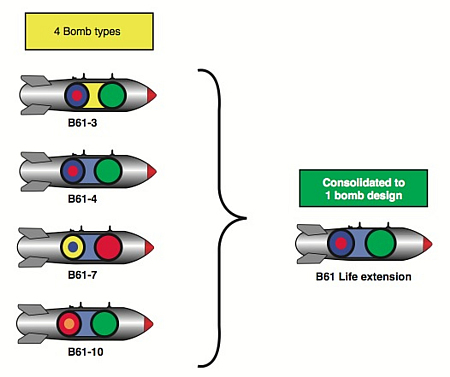 |
| This STRATCOM slide used in the GAO report portrays the B61-12 as a mix of components from existing weapons. The message: it’s not a “new” nuclear weapon. But the slide is missing the most important new component: a new guided tail kit section that will increase the weapon’s accuracy. Image: STRATCOM/GAO |
.
The new guided tail kit – the B61 Tail Subassembly (TSA), as it is formally called – will be developed by Lockheed Martin, Raytheon and Boeing for the Air Force and similar to the tail kit used on the conventional Joint Direct Attack Munition (JDAM) bomb (Boeing has delivered more than 225,000 kits so far). But the B61-12 would be the first time a guided tail kit has been used to increase the accuracy of a deployed nuclear bomb.
The B61-12 accuracy is secret, but officials tell me it is similar to the tail kit on the JDAM (Joint Direct Attack Munition), which uses a GPS (Global Positioning System)-aided INS (Internal Navigation System). In its most accurate mode it provides the JDAM a circular error probable (CEP) of 5 meters or less during free flight when GPS data is available. If GPS data is denied, the JDAM can achieve a 30-meter CEP or less for free flight times up to 100 seconds with a GPS quality handoff from the aircraft. It is yet unclear if the B61-12 will have GPS, which is not hardened against nuclear effects, but many limited regional scenarios probably wouldn’t have sufficient radiation to interfere with GPS.
Officials explain that the increased accuracy will not violate the LEP policy in the NPR because the B61-12 will not have higher yield than the types it replaces. The B61-12 nuclear explosive package (NEP) will be based on the B61-4, which has the lowest maximum yield of the four types to be consolidated. The B61-7, in contrast, has a maximum yield of 360 kt (see table). But while B61-12 does not increase the yield of the B61-7, its guided tail kit will increase the targeting capability compared with the existing B61-3/4 and -10 versions.
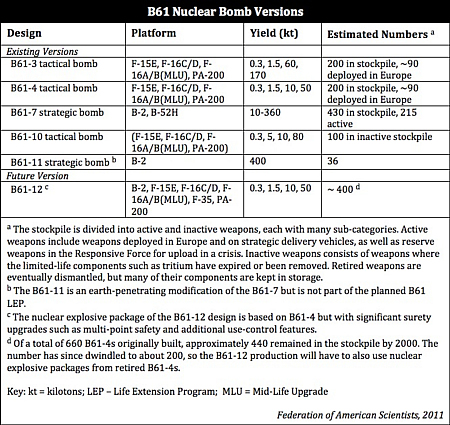 |
| Click on chart to download larger version. |
.
Targeting Implications
Increasing the accuracy of the B61 has important implications for NATO’s nuclear posture and for nuclear targeting in general.
In Europe, the new guided tail kit would increase the targeting capability of the nuclear weapons assigned to NATO by giving them a target kill capability similar to that of the high-yield B61-7, a weapon that is not currently deployed in Europe.
This would broaden the range of targets that can be held at risk, including some capability against underground facilities. In addition, delivery from new stealthy F-35 aircraft will provide additional military advantages such as improved penetration and survivability.
Shock damage to underground structures is related to the apparent (visible) radius of the crater caused by the nuclear explosion. For example, according to the authoritative The Effects of Nuclear Weapons) published by the Department of Defense and Department of Energy in 1977, severe damage to “Relatively small, heavy, well-designed, underground structures” is achieved by the target falling within 1.25 apparent crater radii from the Surface Zero (the point of detonation), and light damage is achieved by the target falling within 2.5 apparent crater radii from the Surface Zero. For a yield of 50 kt – the estimated maximum yield of the B61-12, the apparent crater radii vary from 30 meters to 68 meters depending on the ground (see graph below). Therefore an improvement in accuracy from 100-plus meter CEP (the current estimated accuracy of the B61) down to 30-plus meter CEP (assuming INS guidance) improves the kill probability against these targets significantly by achieving a greater likelihood of cratering the target during a bombing run. Put simply, the increased accuracy essentially puts the CEP inside the crater.
.
The U.S. Department of Defense and NATO agreed on the key military characteristics of the B61-12 in April 2010 – the same month the NPR was published and seven months before NATO’s new Strategic Concept was approved. This included the yield options, that the B61-12 will have both midair and ground-burst detonation options, that it will be capable of freefall (but not parachute-retarded) delivery, and the required accuracy when equipped with the new guided tail section and employed by the F-35. STRATCOM, which provides targeting assistance to NATO, subsequently asked for a different yield, which U.S. European Command and SHAPE (Supreme Headquarters Allied Powers Europe) agreed to. Since the NPR prohibits increasing the military capability, STRATCOM’s alternative B61-12 yield cannot be greater than the current maximum yield of the B61-4.
The GAO report states that “neither NATO nor U.S. European Command, in accordance with the NATO Strategic Concept, have prepared standing peacetime nuclear contingency plans or identified targets involving nuclear weapons.” (Emphasis added). The “no standing plans” claim is correct because regional nuclear strike planning is no longer done with “standing plans” as during the Cold War. But that doesn’t mean there are no plans at all. Today’s strike planning does not require “standing” plans but relies on new adaptive planning capabilities that can turn out a strike plan within days or weeks.
But the “no identified targets” claim raises an obvious question: If NATO and EUCOM have not “identified targets” for the B61 bombs in Europe, how then can they identify the military characteristics needed for the B61-12 that will replace the bombs in 2018? Obviously, some targets have been identified.
The addition of the tail kit eliminates the need for the existing parachute-retarded laydown option, where a parachute deployed from the rear of the nuclear bomb provides for increased accuracy when employed from an aircraft flying at very low altitude (and allows the pilot (and aircraft) to escape the blast). But a GPS/INS tail kit would also give the B61-12 high accuracy independent of release altitude, weather, and axis of aircraft for much greater survivability.
Reinventing PLYWD: Low-Yield Prevision Nuke
Beyond Europe, the guidance tail kit would also have implications for nuclear targeting in general. Although the B61-12 will not be able to exceed the target kill capability of the maximum yield of the B61-7, the increased accuracy will have an effect on the target kill capability at lower yields. Indeed, the B61-12 concept resembles elements of the Precision Low-Yield Weapon Design (PLYWD) program from the early-1990s when the Air Force studied combining low-yield warhead options with precision guidance to reduce collateral damage from nuclear strikes.
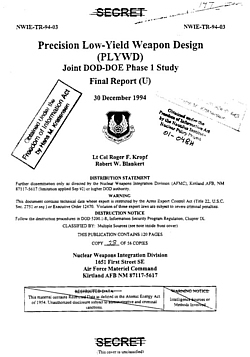 |
| Click on image to download report. |
.
Much of that study remains classified but parts of it were released to me under the Freedom of Information Act (see box). The study concluded that, “The use of precision guidance could permit the Air Force to accomplish some missions as effectively, or more effectively, with low-yield weapons” (emphasis added). Overall, the study found that a precision, low-yield weapon “can be effective against a large fraction of potential targets, can reduce collateral damage on a significant number of targets, is technically feasible, and can provide aircraft standoff (and thus improve survivability).”
PLYWD was rejected by Congress, which banned work on and development of new warheads with a yield of less than five kilotons. Among other things, Congress was concerned that the combination of precision and low-yield to reduce collateral damage would make nuclear weapons appear more useable and risk lowering the nuclear threshold and increase the risk that nuclear weapons would actually be used.
The issue resurfaced in 2001 with proposals to build low-yield nuclear earth penetrators, but the scenarios were shown to be inherently dirty (examples of analysis here, here, and here). Even so, the Bush administration managed to defeat the ban in 2003 in order to explore advanced concepts of nuclear strike options against regional adversaries (see CRS report for background).
The beauty of the B61-12 program is that it avoids a controversial decision to develop a new low-yield nuclear warhead but achieves many of the PLYWD mission goals by combining the existing lower-yield options of the B61 (down to only 0.3 kt) with the increased accuracy provided by the new guidance tail kit to increase targeting capability while reducing collateral damage.
Interestingly, the PLYWD project emerged after EUCOM (now a recipient of the B61-12) pressed for nuclear weapons with lower yields, Los Alamos National Laboratory (the design lab for the B61) proposed a mini-nuke concept, and the Defense Nuclear Agency (now Defense Threat Reduction Agency) began research on “a very low collateral effects nuclear weapons concept.” In fact, both the Military Characteristics (MC) and Stockpile-to-Target Sequence (STS) documents for PLYWD were based on the B61 MC and STS.
In the future, if funded by Congress, the precision B61-12 would allow a B-2, F-35, F-15E, F-16, as well as the next generation long-range bomber, to destroy targets, which previously required high yield blasts, with lower yields and less radioactive fallout.
The Nonproliferation Argument
The relatively lower yield of the B61-4 means that its secondary (CSA, or Canned Sub Assembly) contains less Highly-Enriched Uranium (HEU) that the B61-3, B61-7, and B61-10 versions. Using the B61-4 nuclear explosive package in the B61-12 to replace the three other higher-yield bombs will remove significant quantities of HEU from the deployed force. In other words, so the argument goes, the B61 LEP is a nonproliferation measure intended to reduce the amount of HEU that would be lost if a B61-12 were ever stolen.
This justification is only partly relevant because roughly half of the weapons deployed in Europe already are B61-4 so returning them as B61-12 with the same nuclear explosive package and amount of HEU will not reduce that portion of the deployed force. The HEU-heavy B61-7s are not stored overseas but in the United States (and so are the B61-10s) and most of those are not even at the bomber bases but in central storage facilities.
| B61-7 and JDAM |
 |
| The B61 (front, white) is similar in size to the JDAM (back). All high-yield B61-7s are stored in the United States. Image: USAF |
.
Moreover, the total number of B61-12s to be produced is far lower than the combined number of B61 versions in today’s stockpile – perhaps only around 400, down from an estimated 930 weapons.
Far less clear is how the agencies have determined that the risk of theft of a B61 has increased so much after September 2001 that too much HEU is deployed and existing safety and security features are inadequate to protect the weapons. Not least because a National Academy of Sciences task force recently concluded that “there is no comprehensive analytical basis for defining the attack strategies that a malicious, creative, and deliberate adversary might employ or the probabilities associated with them.” As a result, the task force concluded that it “could not identify how to assess the types of attacks that might occur and their associated probabilities.”
That doesn’t seem to have dampened NNSA’s pursuit of exotic safety and security features for all U.S. nuclear warheads in the name of an increased threat. Ironically, in doing so, NNSA is following White House guidance from 2003 that ordered “incorporation of enhanced surety features independent of any threat scenario” (emphasis added). Apparently, increased surety is not needed because of a specific increased threat but because of a policy.
But no one seems to be asking whether the B61 bombs in Europe are being exposed to unnecessary risks because the Air Force continues to scatter them in underground vaults underneath dozens of aircraft shelters at airbases in five European countries with different security standards; the deployment itself may add to the insecurity of the weapons.
The End of U.S. Non-Strategic Warheads
The B61-12 program marks the end of the 60-year old practice of the U.S. military to have designated non-strategic or tactical nuclear warheads in the stockpile. The only other remaining non-strategic warhead in the stockpile, the W80-0 for the nuclear Tomahawk Land-Attack Cruise Missile (TLAM/N), is also being eliminated.
| A “Tactical” Nuclear Weapons Phase-Out |
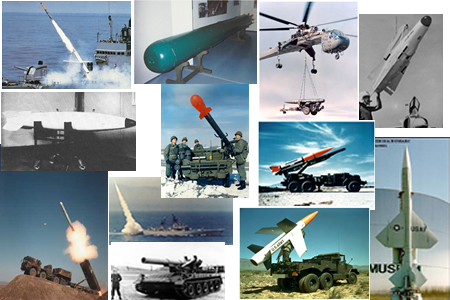 |
| The B61 LEP eliminates the last designated non-strategic (tactical) nuclear warheads from the U.S. stockpile, a category of warheads that used to dominate the U.S. arsenal, making the disparity with Russia’s non-strategic nuclear weapons a non-issue. |
.
With the elimination of the last non-strategic bombs (B61-3, -4 and -10), the B61-4 will be converted to meet the mission requirement of the B61-7; essentially, the non-strategic B61-4 will become a strategic bomb. The B61-12 will be carried by both long-range bombers and short-range fighter-bombers; strategic or non-strategic will be determined by the delivery platform rather than the warhead designation.
Ironically, eliminating non-strategic nuclear warheads and instead using strategic warheads in support of NATO actually meets the language of the Alliance’s new Strategic Concept, which states that “The supreme guarantee of the security of the Allies is provided by the strategic nuclear forces of the Alliance” rather than non-strategic bombs (emphasis added).
Implications and Recommendations
The B61 LEP appears to be much more than a simple life-extension of an existing warhead but an upgrade that will also increase military capabilities to hold targets at risk with less collateral damage.
It is perhaps not surprising that the nuclear laboratories and nuclear warfighters will try to use warhead life-extension programs to increase military capabilities of nuclear weapons. But it is disappointing that the White House and Congress so far have not objected.
The NPR clearly states that, “Life Extension Programs…will not…provide for new military capabilities.” I’m sure we will hear officials argue that the B61 LEP doesn’t provide new military capabilities because it doesn’t increase the warhead yield beyond the maximum of the existing four types.
But this narrow interpretation misses the point. Mixing precision with lower-yield options that reduce collateral damage in nuclear strikes were precisely the scenarios that triggered opposition to PLYWD and mini-nukes proposal in the 1990s. Warplanners and adversaries could see such nuclear weapons as more useable allowing some targets that previously would not have been attacked because of too much collateral damage to be attacked anyway. This could lead to a broadening of the nuclear bomber mission, open new facilities to nuclear targeting, reinvigorate a planning culture that sees nuclear weapons as useable, and potentially lower the nuclear threshold in a conflict.
Such concerns ought to be shared by the Obama administration, which has pledged to reduce the role of nuclear weapons and work to prevent that nuclear weapons are ever used. The pledge to reduce the role of nuclear weapons has received widespread international support but will fall flat if one of the administration’s first acts is to increase the capability of nuclear weapons.
How Russia and NATO allies will react remain to be seen, but increasing NATO’s nuclear capabilities at a time when the United States is trying to engage Russia in talks about limiting non-strategic nuclear weapon seems counterproductive.
These talks could become more complicated because the B61 LEP eliminates non-strategic nuclear warheads from the U.S. stockpile and instead leaves the B61-12 to cover both strategic and non-strategic scenarios. That will further blur the line between strategic and non-strategic weapons and make it a challenge to meet the U.S. Senate’s requirement “to initiate…negotiations with the Russian Federation on an agreement to address the disparity between the non-strategic (tactical) nuclear weapons stockpiles of the Russian federation and of the United States and to secure and reduce tactical nuclear weapons in a verifiable manner.” After the B61 LEP the United States will not have any non-strategic nuclear warheads to negotiate with, essentially making the “disparity” a non-issue.
NATO declared in its Strategic Concept from November 2010 that the alliance “will seek to create the conditions for further reductions in the future” of the number and reliance on nuclear weapons. Increasing the capability of NATO’s nuclear posture appears to contradict that pledge and could lead to increased opposition to continued deployment of U.S. nuclear weapons in Europe.
At the very least, the administration and Congress need to define and publicly clarify what constitutes “new capabilities.” More than $213 billion are planned for nuclear modernizations in the next decade; it’s hard to believe that there will be no “new capabilities” slipping through in that work. In fact, current plans for warhead life-extension programs indicate that the nuclear establishment intends to take full advantage of the uncertainly by increasing the targeting capabilities of the nuclear weapons: it is already happening with the W76 LEP, which is being deployed on submarines with increased targeting capability; it is scheduled to happen with the B61 LEP; and it appears to be planned for the W78 LEP as well.
The logic seems to be: “We’re reducing the number of weapons so of course the remaining ones have to be able to cover more scenarios.” In other words, the price for arms control is increased military capabilities.
The administration should also direct that the portion of the B61-12s that are earmarked for deployment in Europe be deployed without the new guidance tail kit but retain the accuracy of the exiting weapons currently deployed in Europe. Otherwise the B61-12 should not be deployed in Europe.
Finally, the administration’s ongoing nuclear targeting review should narrow the role of nuclear weapons to prevent that numerical reductions become a justification for increasing the capabilities of the remaining weapons. The new guidance must depart from the “warfighting” mentality that still colors nuclear war planning and is so vividly illustrated by the precision low-yield options offered by the B61-12.
NOTE: This blog is also available in PDF format as an Issue Brief.
This publication was made possible by a grant from Carnegie Corporation of New York and Ploughshares Fund. The statements made and views expressed are solely the responsibility of the author.
The FY2026 National Defense Authorization Act (NDAA) paints a picture of a Congress that is working to both protect and accelerate nuclear modernization programs while simultaneously lacking trust in the Pentagon and the Department of Energy to execute them.
While advanced Chinese language proficiency and cultural familiarity remain irreplaceable skills, they are neither necessary nor sufficient for successful open-source analysis on China’s nuclear forces.
Satellite imagery has long served as a tool for observing on-the-ground activity worldwide, and offers especially valuable insights into the operation, development, and physical features related to nuclear technology.
This report outlines a framework relying on “Cooperative Technical Means” for effective arms control verification based on remote sensing, avoiding on-site inspections but maintaining a level of transparency that allows for immediate detection of changes in nuclear posture or a significant build-up above agreed limits.
